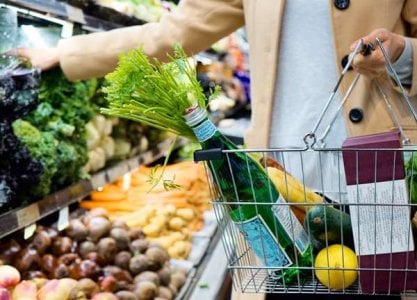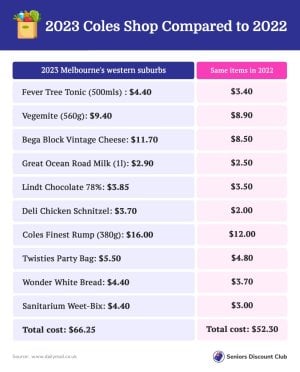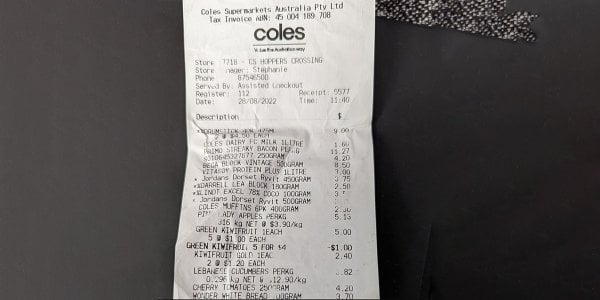The truth about grocery shopping in 2023 through old Coles receipts
Remember the good old days when whipping out a crisp note to pay for your groceries felt a little like holding the winning lottery ticket?
Ah, those were simpler times, weren’t they? As we navigate through the present, with rocketing grocery prices, these memories feel even sweeter.
Inflation has wriggled its way into our shopping lists, altering the numbers next to our favourite products.
The once affordable block of cheese and bargain-priced steak we love? Those staples now seem more akin to luxury items.
Let’s not even get started on the Twisties Party Bag—the after-dinner ritual is now a dollar more expensive.

Yes, inflation has committed the ultimate party foul.
When you return from a trip to the supermarket nowadays and look at old receipts, it can feel like looking into a time capsule, reminding you of more affordable times.
But if you look closely, you'll see that the reality is harsher.
The prices of supermarket items have been rising steadily, and you may have noticed it affecting your wallet.
It's not just your imagination; it's a sign of the times.
Consider this: Fever Tree Tonic you enjoyed over ice during those scorching summer afternoons jumped from $3.40 in 2022 to $4.40 in 2023.
The vintage Bega Block Cheese, the key ingredient in your famous cheese on toast, increased from $8.50 to $11.70.
A loaf of Wonder White Bread rose from $3.70 to $4.40.
The list sadly goes on. See the infographic below for a comparison of Coles' item prices in 2023 versus 2022:
And these prices are not from a boutique supermarket in the heart of Melbourne, but a Coles in the outer western suburbs.
Consequently, providing for a family of four has become increasingly challenging, with the cost of groceries becoming a pressing concern for many households.
According to Canstar Blue's July 2022 survey of supermarket shoppers, Aussie households spent an average of $152 per week on groceries last year.
This translates to nearly $659 per month or approximately $7,904 annually.
For larger households consisting of five or more individuals, the average weekly spending increased to around $235.
According to UBS, a prominent investment bank, food and grocery prices at Australia's major supermarket chains, Coles and Woolworths, experienced an annualised increase of 9.6 per cent in April.
UBS based this analysis on over 60,000 items.
Coles, however, contested the findings.
'UBS’ report is not an accurate reflection of how we calculate and report inflation. UBS’ sample data does not capture our full range of products and does not capture changes in customer buying behaviours which impact our sales volumes and product mix,' said a Coles’ spokesperson.
Some factors contributing to rising food prices are the costs incurred after produce leaves the farm, including energy, processing, and transportation expenses.
Supermarket giants attribute the increase to the higher wholesale prices they are paying to suppliers.
In this challenging environment, bargain hunting has become more crucial than ever, but even with efforts to save money, the savings are not as significant as they were in the past.
Though supermarket visits may have lost some predictability and comfort, viewing this situation as an opportunity to explore and unleash our creativity in shopping strategies is essential.
Here are some savvy shopping tips to help you navigate the changing supermarket landscape:

So, members, shop smarter in today’s trying times.
If you’ve got a smart budget trick, whether it’s buying from ALDI, Coles or your local farmer’s market or something else, share it in the comments below!
Ah, those were simpler times, weren’t they? As we navigate through the present, with rocketing grocery prices, these memories feel even sweeter.
Inflation has wriggled its way into our shopping lists, altering the numbers next to our favourite products.
The once affordable block of cheese and bargain-priced steak we love? Those staples now seem more akin to luxury items.
Let’s not even get started on the Twisties Party Bag—the after-dinner ritual is now a dollar more expensive.

Inflation significantly impacted grocery prices, causing them to rise steadily over time. The increased cost of production, transportation, and raw materials has led to higher consumer prices at supermarkets and grocery stores. Image by socialtyvr from unsplash
Yes, inflation has committed the ultimate party foul.
When you return from a trip to the supermarket nowadays and look at old receipts, it can feel like looking into a time capsule, reminding you of more affordable times.
But if you look closely, you'll see that the reality is harsher.
The prices of supermarket items have been rising steadily, and you may have noticed it affecting your wallet.
It's not just your imagination; it's a sign of the times.
Consider this: Fever Tree Tonic you enjoyed over ice during those scorching summer afternoons jumped from $3.40 in 2022 to $4.40 in 2023.
The vintage Bega Block Cheese, the key ingredient in your famous cheese on toast, increased from $8.50 to $11.70.
A loaf of Wonder White Bread rose from $3.70 to $4.40.
The list sadly goes on. See the infographic below for a comparison of Coles' item prices in 2023 versus 2022:
And these prices are not from a boutique supermarket in the heart of Melbourne, but a Coles in the outer western suburbs.
Consequently, providing for a family of four has become increasingly challenging, with the cost of groceries becoming a pressing concern for many households.
According to Canstar Blue's July 2022 survey of supermarket shoppers, Aussie households spent an average of $152 per week on groceries last year.
This translates to nearly $659 per month or approximately $7,904 annually.
For larger households consisting of five or more individuals, the average weekly spending increased to around $235.
According to UBS, a prominent investment bank, food and grocery prices at Australia's major supermarket chains, Coles and Woolworths, experienced an annualised increase of 9.6 per cent in April.
UBS based this analysis on over 60,000 items.
Coles, however, contested the findings.
'UBS’ report is not an accurate reflection of how we calculate and report inflation. UBS’ sample data does not capture our full range of products and does not capture changes in customer buying behaviours which impact our sales volumes and product mix,' said a Coles’ spokesperson.
Some factors contributing to rising food prices are the costs incurred after produce leaves the farm, including energy, processing, and transportation expenses.
Supermarket giants attribute the increase to the higher wholesale prices they are paying to suppliers.
In this challenging environment, bargain hunting has become more crucial than ever, but even with efforts to save money, the savings are not as significant as they were in the past.
Though supermarket visits may have lost some predictability and comfort, viewing this situation as an opportunity to explore and unleash our creativity in shopping strategies is essential.
Here are some savvy shopping tips to help you navigate the changing supermarket landscape:
- Create a Shopping List: Stick to the classic method of making a list before you head to the store. It's a valuable tool to steer clear of impulsive and costly purchases.
- Utilise Discounts: Keep an eye out for discount offers, both in-store and online. Weekdays might offer new deals worth checking out.
- Opt for Seasonal Produce: Save money and enjoy fresher options by choosing seasonal fruits and vegetables. It's a win-win situation!
- Compare Prices: Before making a purchase, take advantage of comparing prices from different stores. This simple step can help you save more than just a few bucks.
- Utilise Coupons and Cashback Apps: Nowadays, there's a wide range of coupons and cashback apps available. These tools can further boost your savings.
- Access Online-Only Deals: Keep an eye out for exclusive deals that might only be available online. Seizing such opportunities can lead to extra savings.
Key Takeaways
- The cost of groceries at Coles supermarkets in Australia has significantly increased, as shown by old shopping receipts.
- A simple, everyday shop now costs more than the previous year.
- Average Australian households reportedly spent about $152 per week on groceries last year, which has likely increased this year.
- Coles disputes the figures of the increase, stating that product range and changes in customer buying behaviour were not considered.
So, members, shop smarter in today’s trying times.
If you’ve got a smart budget trick, whether it’s buying from ALDI, Coles or your local farmer’s market or something else, share it in the comments below!









